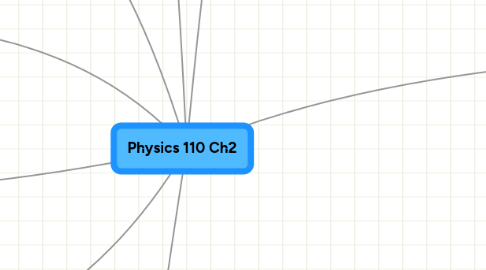
1. Words of Day
1.1. Ramp up
1.1.1. Build up confidence
1.1.2. Strengthen
1.2. Chains
1.2.1. Talking about tension
1.3. Link up
1.3.1. Put together pieces
1.3.2. logical connection
1.4. Elan
1.4.1. Vigorous spirit
1.4.2. Enthusiasm
2. Velocity
2.1. Vector
2.1.1. Magnitude
2.1.1.1. Speed at which object moves
2.1.2. Direction
2.1.2.1. Direction of motion
2.1.3. Adding Vector Graphs
2.1.3.1. Draw arrows
2.1.3.2. Use
2.1.3.2.1. Ruler
2.1.3.2.2. Protractor
3. Scalar
3.1. Magnitude
3.2. Algebraic sign
3.3. Units
3.4. No direction
3.5. Types
3.5.1. Mass
4. Problems
4.1. 3kg water + 2kg water
4.1.1. 5kg water =
4.2. 300N + 200N
4.2.1. Depends on direction
4.2.1.1. 500N =
4.2.1.2. 100N =
4.3. Relationship between mass and weight
4.3.1. W= mg
4.3.1.1. g, the weight of an object of mass m near Earth's surface
4.3.1.2. g = 9,80 N/kg
5. Newton's Laws
5.1. Newton's first Law
5.1.1. Law of Inertia
5.1.1.1. An object's velocity does not change if and only if the net force acting on the object is zero (Pg 29)
5.1.1.2. Inertia- resistance to changes in velocity
5.2. Newton's Third Law
5.2.1. Interaction partners always have the same magnitude and are in opposite directions
5.2.2. Example
5.2.2.1. You push open door and the door pushes on you
5.2.2.1.1. Forces on two objects
5.2.2.2. Two cars collide
5.2.2.2.1. Each exerts a force on the other
5.2.3. Do not assume involvement of Law every time two forces happen to be equal and opposite
5.2.3.1. 2 children fighting over toy
5.2.3.1.1. They are acting on the same object
5.3. Newton's Law of Universal Gravitation
5.3.1. Any two objects exert gravitiational forces on each other that are proparotional to the masses of the two objects and inversely proportional to the square of the distance between their center
5.3.2. Pg 40
6. Equalibrium
6.1. Net force acting on an object is zero
6.2. Forces are in balance
6.2.1. There is as much force upward as there is downward
6.2.2. As much force to the right as there is to the left
6.3. Any object with constant velocity, whether at rest or moving in a straight line at constant speed (Pg32)
7. Force
7.1. Types
7.1.1. Electromagnetic
7.1.1.1. Electric charge in motion
7.1.2. Weak forces
7.1.3. Strong forces
7.1.4. Tension forces
7.1.4.1. Muscles
7.1.4.2. Pulleys
7.1.4.2.1. Ideal Pulley
7.1.4.3. The act or process of stretching something tight
7.1.5. Long-range forces
7.1.5.1. Do not require objects to touch
7.1.5.2. Gravity
7.1.5.2.1. Weight
7.1.6. Contact force
7.1.6.1. Exists only as long as objects are touching one another
7.1.6.2. Normal forces
7.1.6.2.1. Equal
7.1.6.2.2. A contact force between two solid objects that is perpendicular to the contact surface
7.1.6.3. Friction
7.1.6.3.1. A contact force parallel to the contact surface
7.1.6.3.2. Static Friction
7.1.6.3.3. Kinetic Friction
7.1.7. Internal Interaction
7.1.7.1. Both interacting objects are part of the system
7.1.7.2. When we add up all the forces acting on the system to find net force
7.1.7.2.1. Every internal interaction contributes two forces
7.1.8. External Interaction
7.1.8.1. Only one of the two interaction partners s exerted on the system
7.1.8.2. The other partner is exerted on an object outside the system
7.1.8.2.1. Does not contribute to the net force on the system
7.2. Push or Pull
7.2.1. Move something away or move something toward
7.3. Measuring Forces
7.3.1. SI Unit
7.3.1.1. Newton (N)
7.3.1.1.1. 1 lb= 4.448N
7.3.2. A force is measured by the deformation-Change of size or shape-it produces in object
7.4. Vector
7.4.1. Magnitude
7.4.1.1. Size or Extent
7.4.2. Direction
7.4.2.1. A line leading to a place or point
7.4.3. Adding Vector Graphs
7.4.3.1. Draw arrows
7.4.3.2. Use
7.4.3.2.1. Ruler
7.4.3.2.2. Protractor
